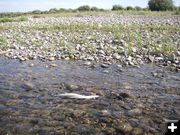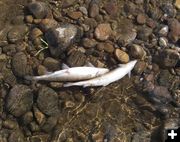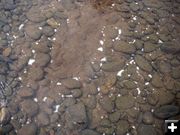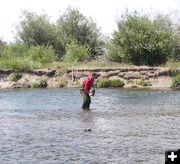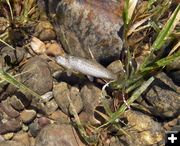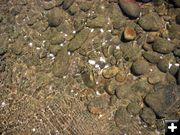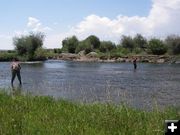
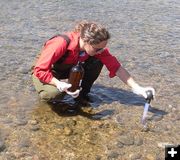
Siphoning up globules
Biologists used turkey basters to suck up dense hydrophobic globules of chemical. They were not able to remove all of the materials. The chemical will be analyzed to determine exactly what it is.
|

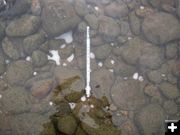
Showing Size
The thermometer shows the relative size of the chemical globules.
|

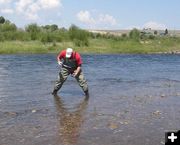
Cleaning up chemical
A biologist works to suck up chemical globules. It is unknown how much more may have washed downstream.
|
|
Pesticide spill in the Green River
Malathion suspected
July 29, 2007
Fisheries biologists from the Pinedale office of the Wyoming Game & Fish reported Sunday that they had been made aware of a chemical spill into the Green River approximately ¾ mile upstream from Hwy 189 just north of Daniel. The exact date of the spill has not been determined, but is believed to have been between Tuesday evening, July 24 and Wednesday morning, July 25, 2007. An angler reported the apparent spill to the Pinedale Game & Fish office.
The chemical is believed to be malathion, based on the smell, said Regional Fisheries Supervisor Hilda Sexauer. Samples of the chemical were taken and given to the Environmental Protection Agency to perform further tests to try and positively identify the substance. The quantity released into the Green River is not known.
According to the Game & Fish media release, there were reports of 300 or more dead fish in the spill area. The fish killed were brown trout and whitefish. Malathion is acutely toxic to rainbow trout at a concentration of 0.200 MG/L. This chemical is toxic to fish, aquatic invertebrates, and aquatic life stages of amphibians.
"I visited the site of the fish kill on Friday July 27th to access the kill and identify the cause. Approaching the site a strong chemical order was apparent. Large globs of white gelatinous masses were observed in the Green River and many dead fish were observed. The white globules are spread over approximately 200 meters of shallow riffle area, but are probably contaminating a larger area downstream," said Sexauer.
The extent of the spill and impact on the fisheries and biology of the river are unknown at this time. Officials are investigating to attempt to determine more information on the date of the spill and the quantity that was released.
The Wyoming Department of Environmental Quality (DEQ) was contacted on Friday July 27th and they were on site the morning of July 28th. Officials collected samples and gathered information to assess the extent of the spill. Biologists tried to clean up as much of the globules of chemical they could find. Wyoming DEQ is currently analyzing samples and is formulating a plan of action for clean up and or remediation, if necessary.
“The white materials were placed in amber glass bottled jar. Both fish and jars were immediately placed in a cooler with ice. Photos were taken of the dead fish and the white material. The evidence was brought back to the Game and Fish Office and was appropriately marked and placed either in the refrigerator or freezer,” Sexauer said in her report
On Saturday, we started removing what appears to be malathion concentrate in the cobble and gravel substrate of the river. Turkey basters were used to remove these dense hydrophobic globules. However we were not successful in removing all the materials. We collected nine, 1-liter bottles of the toxicant. Clean up was targeted at what appeared to be the point of origin,” Sexauer stated. “The amount released into the Green River is unknown and probably can not be accurately assessed because we were late in being informed of the spill. The riparian area on both sides of the river has a pungent strong order of malathion smelling chemicals.”
Wyoming Game & Fish officials contacted the landowners immediately at the site and downstream of the spill on Friday, July 27th.
Malathion is an insecticide that has been used in the United States for 50 years for mosquito control. It is considered safe to use around humans when applied in accordance with the rate of application and safety precautions specified on the label. In mosquito control programs, malathion is applied by aircraft-mounted or truck-mounted sprayers. It is applied as an ultra-low volume spray, dispensed as very fine aerosol droplets that stay aloft and kill mosquitos on contact. When applied as directed, it kills mosquitos without posing unreasonable risks to human health or the environment. Malathion is also used to kill head lice on humans, fleas on pets and to kill insects in gardens. Malathion is highly toxic to insects, including beneficial insects such as honeybees.
At high doses, malathion can overstimulate the nervous system causing nausea, dizziness, or confusion. Severe high-dose poisoning can cause convulsions, respiratory paralysis and death. People exposed to levels of malathion below those that affect the function of the nervous system tend to experience few or no health problems, according to studies
Malathion degrades rapidly in the environment, especially in moist soil, and it displays low toxicity to birds and mammals. Malathion stays in the environment from a few days to several months, but is usually broken down within a few weeks. Malathion is broken down to other chemical compounds by water, sunlight, and bacteria found in soil and water. It does not tend to stick to the soil and is rapidly broken down by bacteria. In water, malathion breaks down quickly by the action of the water and the bacteria in the water.
EPA toxicity reports note that there is a potential risk from malaoxon, a more toxic compound that is formed from malathion under certain conditions. For example, malathion runoff and spray drift may reach drinking water sources downstream from where the malathion was used. Malathion present in untreated water will form malaoxon during the chlorination process in water treatment facilities. Malaoxon can also form more slowly when malathion is deposited on hard, dry surfaces and exposed to air over time.
Sexauer said there are no health hazard advisories at this time from this spill. DEQ officials told her it is safe to eat fish from the Green River and there are no hazards to livestock that drink the water, or for those who use water from the Green River for irrigation purposes downstream from the spill.
Sexauer said the chemical they observed still in the water on Friday was upstream from the fishing boat access site on Hwy 189 north of Daniel and they did not observe any chemical in the boat launch area or downstream from there. They have contacted anglers in the area, and local fishing outfitters, to see what further information they can provide about the incident and the extent of the spill downstream.
For questions about this incident, or to provide information about the spill, please contact Hilda Sexauer, Regional Fisheries Supervisor, Wyoming Game and Fish Department, PO Box 850, Pinedale, WY 82941, 307-367-4352, hilda.sexauer@wgf.state.wy.us.
|
